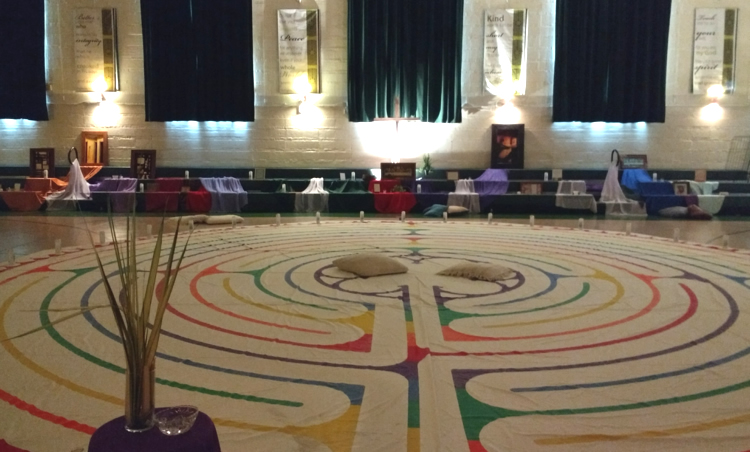
Labyrinth at St. Celestine Site
We experience this type of prayer during Holy Week at St. Celestine Site usually in the School Gym and Annex.
Anyone interested in borrowing our Rainbow Labyrinth for their church should contact the Pastoral Center at 708-453-2555 for rental information.
What is the Labyrinth?
The labyrinth is a simple walking path used to meditate or quiet the mind. It is a path of reflection, contemplation and clarity. Labyrinths come in many sizes and patterns, but a labyrinth has only one path. The path winds throughout and becomes a mirror for where we are in our lives. The labyrinth is a wonderful tool for re–connecting the mind, body and spirit. For some, it allows self–realization that provides peace, healing, and comfort.
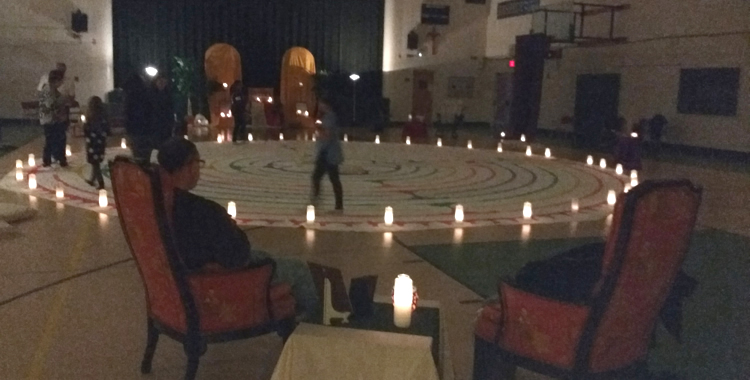
The labyrinth is an ancient pattern found in many cultures around the world. Labyrinth designs were found on pottery, tablets, and tiles date as far back as 4,000 years. Many patterns are based on spirals from nature. In Native American culture it is called the Medicine Wheel and Man in the Maze. The Celts described it as the Never Ending Circle. It is also called the Kabala in mystical Judaism. One feature they all share is that they have one path that winds in a circuitous way to the center.
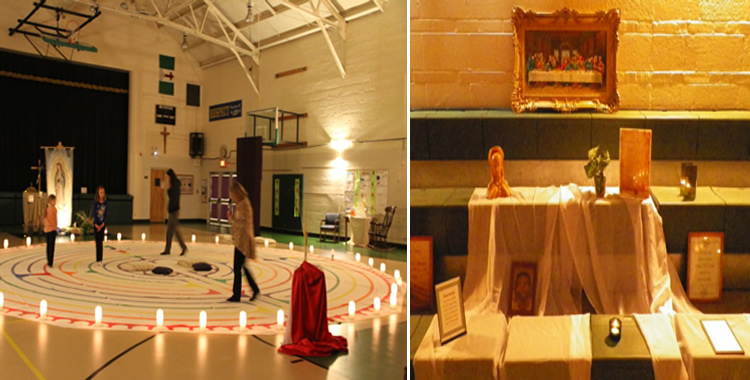
Early in Church history going on “the Way” or, later, on a “pilgrimage” to places such as Guadalupe, Czestochowa and Compostella were seen as a prayer discipline. Processionals as prayer arose from the same understanding. During the Middle Ages when the Crusades closed the route of Christian pilgrims to the Holy Land, two forms of walking meditation surfaced: the “Stations of the Cross” and the labyrinth. Perhaps the best known labyrinth in this tradition is the one on the floor of Chartres Cathedral in France which is the one our St. Celestine Labyrinth is based upon.
Labyrinths are currently being used world–wide as a way to quiet the mind, find balance, and encourage meditation, insight and celebration. They are open to all people as a non–denominational, cross-cultural tool of well–being. They can be found in medical centers, parks, churches, schools, prisons, memorial parks and retreat centers as well as in people’s backyards.
The labyrinth is not a maze. There are no tricks to it and no dead ends. It has a single circuitous path that winds into the center. The person walking it uses the same path to return and the entrance then becomes the exit. The path is in full view, which allows a person to be quiet and focus internally. Generally there are three stages to the walk: releasing on the way in, receiving in the center and returning; that is, taking back out into the world that which you have received. There is no right way or wrong way to walk a labyrinth. Use the labyrinth in any way that meets what you need.
What does Labyrinth Walking involve?
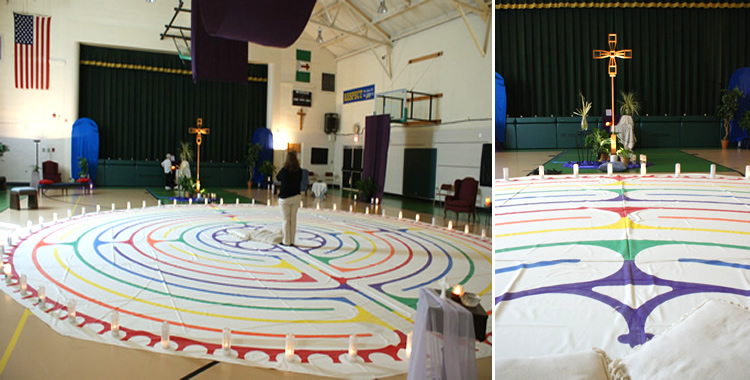
One walks a labyrinth into the center and then out of the center on the same path. Walk the labyrinth with an open mind and an open heart. Take a moment before entering to pause and clear your mind. Become aware of your breath. Enter the labyrinth allowing your body to set its own pace. You may “pass” people or let others step around you whichever is easiest at the turns. The path is two ways. Those going in will meet those coming out. Do what feels natural.
There are three phases to the labyrinth walk:
- Entering: Release and let go of the details of your life. This is an act of shedding thoughts and emotions. It quiets and empties the mind.
- Illumination: (Also called “communion”) This is when you have reached the center. This is a place of meditation. Pause and receive what is there for you.
- Exiting / re-integration: Walk out the same path you entered. Integrate and connect your thoughts.
Tips for the Labyrinth Walk
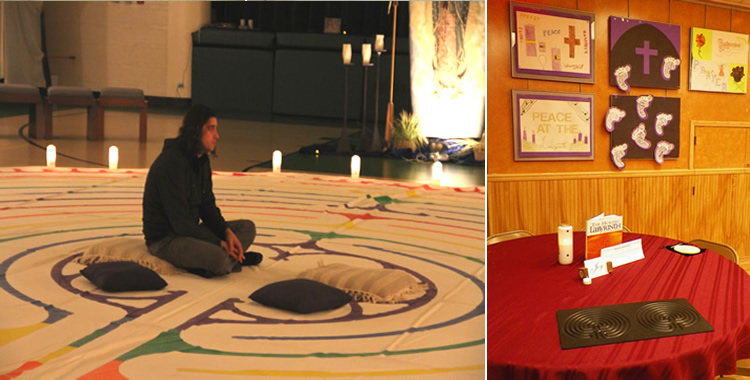
- If others are using the labyrinth, please refrain from talking.
- There are handouts available for your use.
- Please walk the labyrinth in your stocking feet.
- It takes about 20-30 minutes to walk the path.
- Walk at your own pace.
- If multiple people are using the labyrinth, please wait until the person in front of you has rounded the third turn (near the center) before you begin walking the path.
- You may pass another person. The best place to pass is at a corner turn. If you meet someone coming the opposite direction, making eye contact with the other person is a good way to give/obtain permission to pass.
- Before you leave, stop by the table, and:
- Cross off the next number on the sheet. We would like to keep track of the approximate number of those who walked the labyrinth.
- Feel free to share your thoughts about your experience in our journal.
What has been proven?
The labyrinth often brings a participant relaxation and peace. It can provide insights and improve one’s ability to cope with stress. Some anecdotal evidence suggests that it may lower blood pressure.
Virtual Labyrinth Experience
We are pleased to share many resources so you may enjoy the Labyrinth anytime, anywhere.
PDF files of labyrinth text, readings, and finger labyrinth’s for you to print:
- CLICK HERE for one PDF with all the following files
Or click on them separately:
- Chartres Finger Labyrinth – Basic Layout (PDF)
- Chartres Labyrinth with Instructions (PDF)
- Cretan Labyrinth with Instructions (PDF)
- Roman Labyrinth with Instructions (PDF)
- Children and the Labyrinth – Info and Print and Color Pages (PDF)
- Labyrinth Sacred Design (PDF)
- Labyrinth by Lauren Artress (PDF)
- Personal Labyrinth Journal (PDF)
- Praying the Labyrinth for Many Centuries (PDF)
- The Labyrinth is… (PDF)
- What is the Labyrinth? (PDF)
Suggestions for meditative music – CLICK HERE (PDF)
Links to learn more about the Chartres Cathedral Labyrinth and watch video clips plus other documentaries about the meaning and symbolism of it – CLICK HERE (PDF)
Labyrinth Journey App for your phone, tablet or touch screen device. Found on the App Store and Google Play – https://www.labyrinthjourney.app
Labyrinth Candle Memoriam
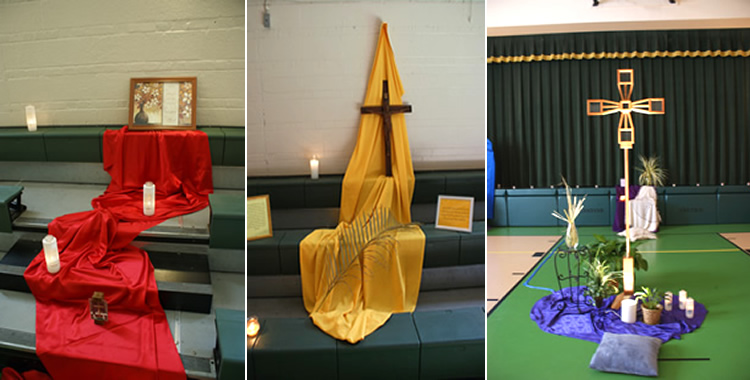
Many of the candles that surround the actual labyrinth are in memory of beloved parishioners. The list below includes names of people who had a candle in memory of them that burned till its end while in use at the St. Celestine Labyrinth. The Labyrinth Committee would like to keep the memory of these people here as a beautiful way to honor the use of the candle. As more candles are burned and retired each year at the labyrinth, more names may be added in the future. Candles are used randomly and not in any particular order.
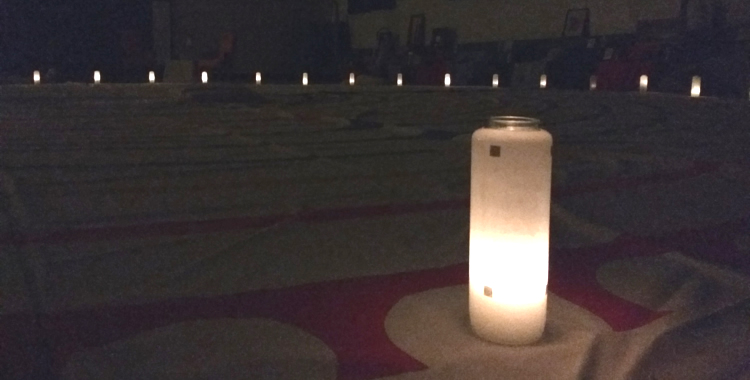
“I am the Resurrection and the Life.” – John 11:25
In loving memory of…
Judith Abraham
Grace Ballaglia
Paul Banks
Damian Bellocchio
Joseph Bodner
Beverly Brani
Ruth Calandra
Frank Carbonara
Raymond Capa
Maria Carbonaro
Joan Cardelli
Katherine Carpenter
Isaiah Cataldo
Eleanor Chiczewski
Marie Collins
Josephine Coniglio
Lonis Corona
Gino Dal Cerro
Louise DeMatteo
Bruno DePasquale
Robert Dulian
Lucille Fazio
Joseph Fontana
Anna Foys
Carmela Furno
Cecilia Giebutowski
Elise Gonclarz
Maria Gonzalez
Barbara Gronke
Geraldine Guzalso
Irene Hadamik
Nick Horin
Elizabeth Jacobs
Tonee Jakubowski
Marie Janke
Peter Kaminski
Raymond Karolewicz
Mary Koszewski
Edward Krajecki
Edward Kruk
Julia Kunstadt
Adela Lang
Joseph Lenhardt
John LLewelyn Loverher
Alice Malenk
Cecilia Maziarz
Marilyn McCallister
Joseph McGarry, Jr.
Richard Merkelz
Alice Molenk
Antonio Montablana
Genevieve Mroz
Terence Mullins
Annie Nalezny
Jean Niedziela
Viola Nuccio
Raymond Olsen
Mary Paolicchi
Violet Pavese
James Payitucci
Julia Perilli
Roseland Prugar
Henry Pryor
Dennis Pyzik
Frank Reda, Sr.
Catherine Reuter
Barbara Schultz
Giovanni Scudiero
Margaret Sells
Glenn Small
Norma Snyder
George Sobiek
Sister Marie Philomena Spidel
Estelle Stuber
Geoffrey Sweborg
Cecilia Tactaquin
Rocco Taglia
Joe Tnrilli
Joseph Tomaselli
Enrique Torre
Enrique Torres
Lorraine Ventresca
Ben Vitale
Antonio Vitali
Dan Vitellaro
Father Bernard C. White
Alexander Wolyniec
Renee Wroble
Lorraine Zahn